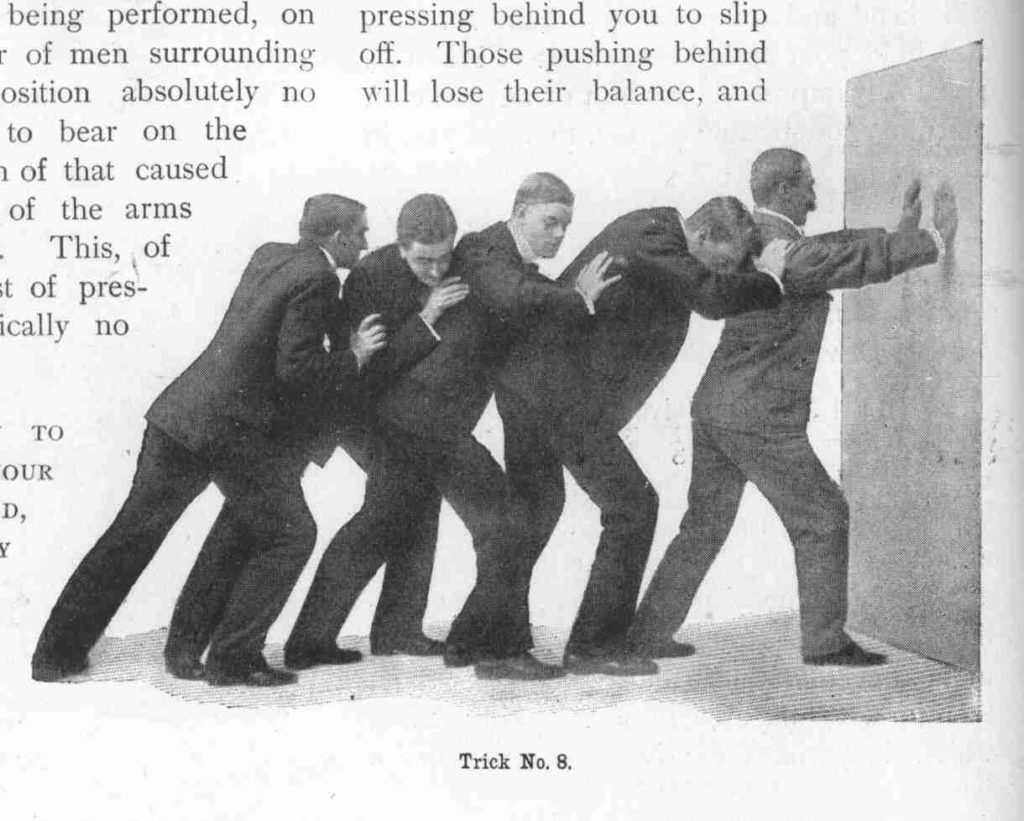- Originally published on the Bartitsu.org site on Sunday, 16th January 2011

Bartitsu founder E.W. Barton-Wright’s article How to Pose as a Strong Man was first published in the January, 1899 edition of Pearson’s Magazine. Presented as an instruction manual of eleven parlour tricks for amateur entertainers, the article doubled as an expose of feats that had been made famous by vaudeville and music hall performers such as Lulu Hurst and Annie May Abbott.
Hurst, Abbott and their imitators claimed that they possessed a mysterious electrical or magnetic force that allowed them to overcome or resist the strength of large, strong men, often with the use of simple props such as chairs, pool cues, walking canes or umbrellas.
This report from the Fielding Star, 25 October 1899, is typical:
(Annie Abbott) is only a small person weighing 100 lbs and yet strong men were unable to lift her whenever she desired to offer resistance – a resistance which evidently was not mere physical strength, but a wonderful power which she possesses. On the other hand she was able to raise men with a mere touch of the hand. One of her most extraordinary feats was where seven men were piled on a chair and Miss Abbott raised the mass of humanity a few inches off the stage by a mere touch of the hand.
Experiments with boys were also extraordinary. A boy from the audience was asked to stand in the centre of the aisle, half way down the hall, and a gentleman in the audience was asked to lift him off his feet. Under ordinary circumstances this could easily have been done, but Miss Abbott exercised some unknown power over the boy and the gentleman was unable to lift him off his feet. Various other tests were given by Miss Abbott, and in all she successfully resisted the forces pitted against her, giving an astounding manifestation of some force other than that making up the ordinary phenomena of nature.
As an engineer with a background in martial arts training and an interest in both electrical technologies and showmanship, Barton-Wright was almost uniquely qualified to assess and explain these “tests”:
It must not be supposed that it is necessary to possess any unusual strength to pose as a strong man; indeed, in many strong men’s feats, strength plays a less important part than knack and trickery.
… (The Georgia Magnet) declared that it was solely owing to the fact that she possessed remarkable magnetic and electric powers that she was able to perform these feats. This, of course, was not the case, for anyone of average strength, who follows these instructions, will be able to perform them.
The article explains the feats of the “Electric Girls” as demonstrations of trickery via subtle bio-mechanics and the power of suggestion, making clever use of leverage and the ideomotor effect. Some twenty years later, magician, escapologist and arch-skeptic Harry Houdini would also pick up on the relationship between martial arts techniques and those of the music hall charlatans …
… who gave the world of science a decided start about a generation ago.
The jiu jitsu of the Japanese is, in part, a development of the same principles, but here again much new material has been added, so that it deserves to be considered a new art.
– Harry Houdini, Miracle Mongers and their Methods, 1920
These feats are amusing to perform and can be useful in teaching skills of balance manipulation, but it is ironic that despite being thoroughly debunked over a hundred years ago, they are still sometimes exhibited as demonstrations of unexplained (para)physical power. A novel commercial twist may be seen in the “tests” associated with products such as wristbands or pendants claimed to be imbued with “frequencies” that improve balance, strength and flexibility:

